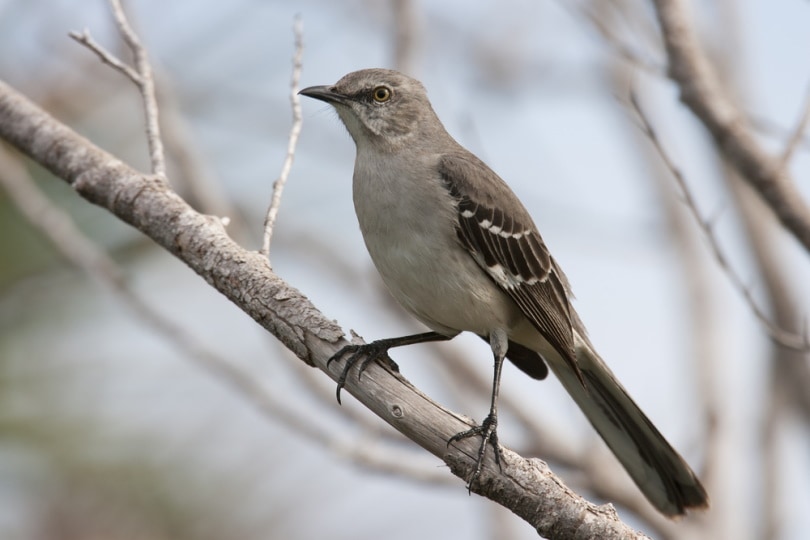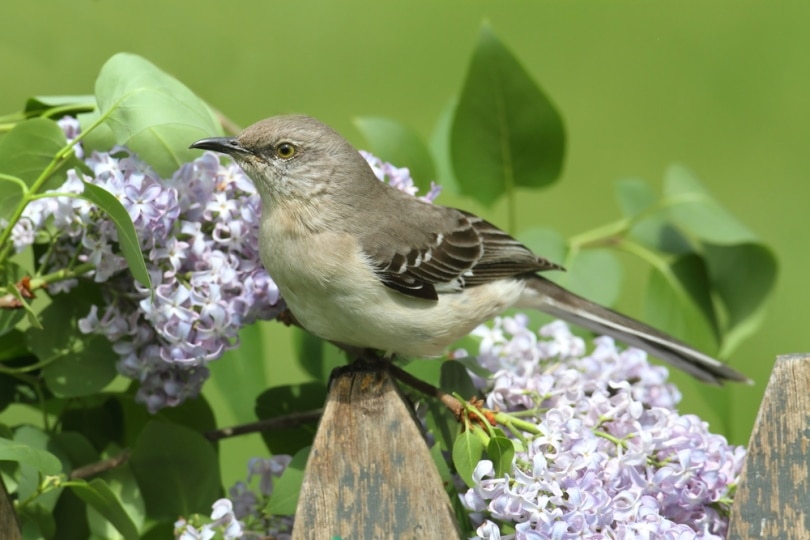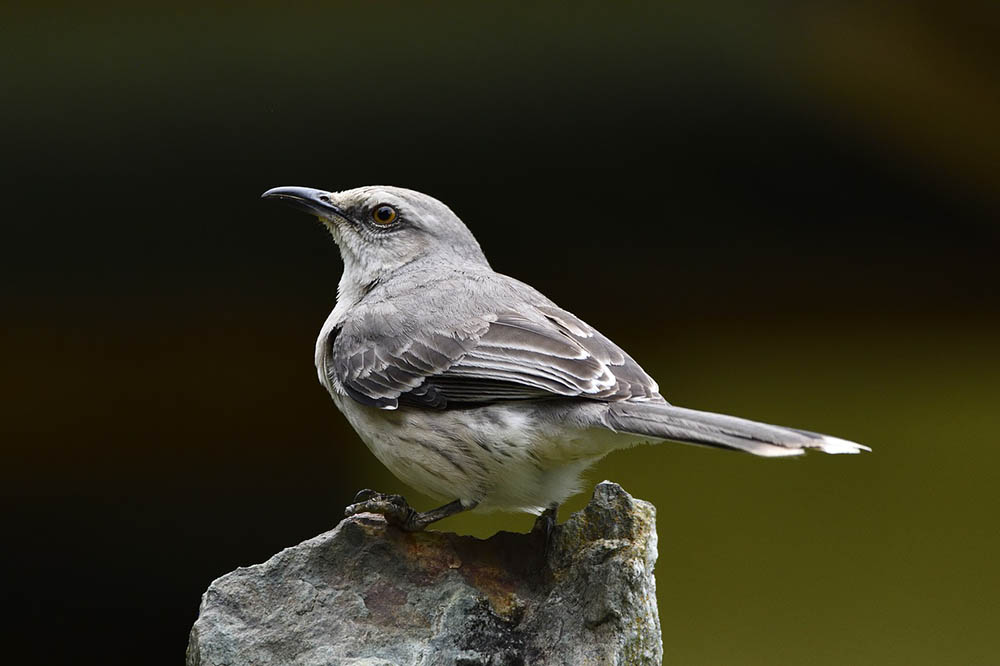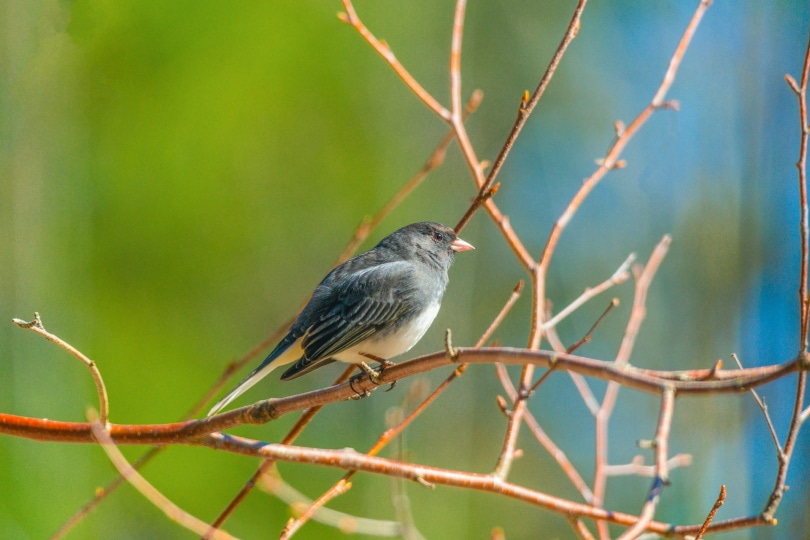Northern Mockingbird: Field Guide, Pictures, Habitat & Info
Last Updated on

The Northern mockingbird might be the most intriguing of its kind in the Northern hemisphere, and it’s a fascinating species to study. This comprehensive guide will lay out all of the info you need to identify this species in addition to their lifestyle and habits. We’ve also put together a handful of images to give you a proper visual of the mockingbird, so you can easily identify it.

Quick Facts about Northern Mockingbirds
| Habitat | Suburbia |
| Diet | Omnivorous |
| Behavior | Foraging on the ground |
| Nesting | Bushes and shrubs |
| Conservation | Low-risk |
| Scientific name | Mimus polyglottos |
| Lifespan: | Around 8 years |
Northern Mockingbird General Description
The standout feature of the Northern mockingbird is its innate ability to copy or “mock” the calls of individual birds. For example, the black-capped chickadee is famous for its “chickadee-dee-dee” song, and its call can be mimicked accurately by a mockingbird. The bird has grey, brown, and white plumage across its body, with bright-yellow eyes and a slightly curved bill. They also have a long “tail” of feathers in the rear, giving them a slim look.

Northern Mockingbird Range, Habitat, Behavior, Diet & Nestin
Range
Throughout North America, the mockingbird can be found across all 48 contiguous United States, most of Mexico, and the southern regions of Canada that border the states. They often stay in the same area all year, with only some mockingbirds that fly down south into Mexico, but they do not breed there.
Habitat
The mockingbird lives in towns, suburbs, and parks, and they are not afraid of living near humans. However, they can live in rural areas as well.
Behavior
Mockingbirds are ground foragers, and they keep low and search for bugs such as caterpillars and fish scraps for their carnivorous meals. Otherwise, they search berry bushes, fruit-bearing trees, and seed-bearing plants to gather food.

Diet
The diet of a Northern mockingbird varies since they are omnivorous. As we mentioned, the birds are fond of insects but also eat fish or anything they need to stay alive. However, they like eating mulberries, blackberries, and other fruity vegetation.
Nesting
Mockingbirds live in various habitats but mostly congregate in urban areas. While living close to towns and households, the birds may nest on telephone poles, hedges, garden bushes, and wooden fixtures.
How to Find Northern Mockingbirds: Birdwatching Tips
What to Listen For
The mockingbird can learn up to 200 unique songs from other birds. This makes it tricky to identify them, but if you hear a lot of intermingled calls from a single area, that could indicate that there is one nearby.
What to Look For
When searching for a Northern mockingbird, you’ll want to look around bushes or ground-level vegetation they may be feeding on. Keep an eye out for their yellow eyes and greyish coat.

When to Look
Mockingbirds are mostly sighted during most daylight hours, but it’s advised that you check during dusk and dawn as well.
Attracting Northern Mockingbirds to Your Backyard: Tips & Tricks
Most Northern mockingbirds aren’t keen on feeders, but here are a few backyard tips:
- Grow bushes or shrubs in your yard
- Offer berries such as hawthorns, mulberries, and blackberries
- Keep your backyard relatively open and free from obstructions

Northern Mockingbird Conservation: Is this Bird Threatened?
There was a time when mockingbirds were highly sought after and were caged—wiping out much of the eastern population. Due to their prevalence in American suburbia today, the Northern mockingbird is not on the close watch list for endangered animals. However, environmental changes could cause them to travel farther north if temperatures rise.

Conclusion
Northern mockingbirds are extraordinarily talented at copying the calls of neighboring species, and they were once a prized possession by collectors. Today, birdwatchers can witness them from afar and attempt to identify them through their unique songs. This field guide should bring you closer to them so you can tell whether you’ve got a real blue jay or an imposter!
Featured Image Credit: Stubblefield Photography, Shutterstock
Table of Contents
- Quick Facts about Northern Mockingbirds
- Northern Mockingbird General Description
- Northern Mockingbird Range, Habitat, Behavior, Diet & Nestin
- How to Find Northern Mockingbirds: Birdwatching Tips
- Attracting Northern Mockingbirds to Your Backyard: Tips & Tricks
- Northern Mockingbird Conservation: Is this Bird Threatened?
- Conclusion
About the Author Robert Sparks
Robert’s obsession with all things optical started early in life, when his optician father would bring home prototypes for Robert to play with. Nowadays, Robert is dedicated to helping others find the right optics for their needs. His hobbies include astronomy, astrophysics, and model building. Originally from Newark, NJ, he resides in Santa Fe, New Mexico, where the nighttime skies are filled with glittering stars.
Related Articles:
10 Types of Hummingbirds in Arkansas (With Pictures)
8 Types of Hummingbirds in Nebraska (With Pictures)
5 Types of Hummingbirds in Idaho (With Pictures)
3 Types of Hummingbirds in Mississippi (With Pictures)
8 Types of Hummingbirds in Kansas (With Pictures)
5 Types of Hummingbirds in West Virginia (With Pictures)
5 Types of Hummingbirds in Ohio (With Pictures)
Where Do Nuthatches Nest? Nuthatch Nesting Habits Explained
